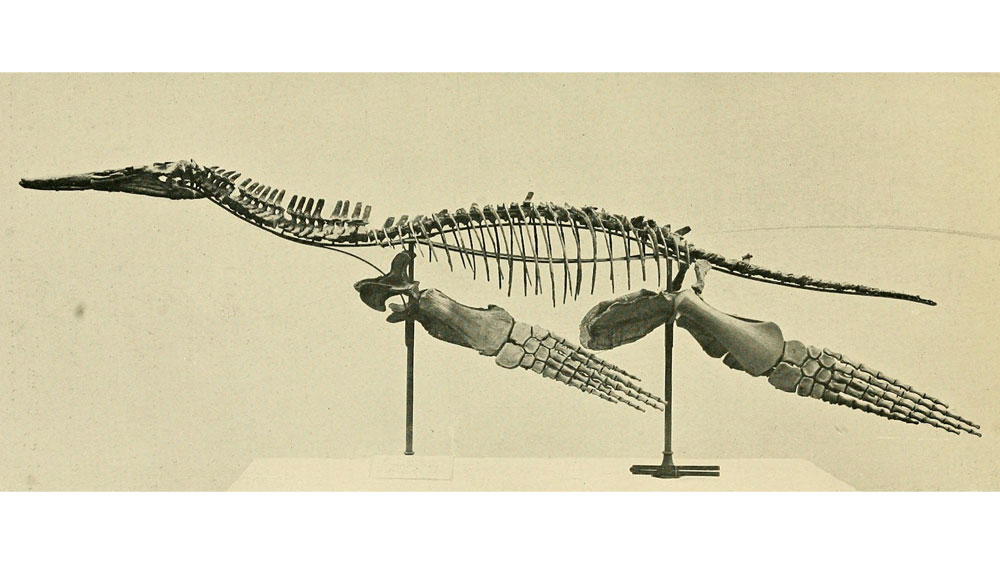A recent article published by Hakai Magazine claims to reveal secrets of an ancient inland sea that existed east of the Andes Mountains,1 but it really just offers poor explanations for an already murky evolutionary tale and leaves the reader wondering.
Santiago Flórez describes a multitude of fossils found in the Paja Formation near the town of Villa de Leyva, Colombia.1 Paleontologists have unearthed 10-meter-long (33 ft) marine reptiles called pliosaurs, equally long plesiosaurs, and countless ammonites in the same Lower Cretaceous unit, which evolutionists claim was deposited about 130 million years ago.2
Flórez also describes wonderfully preserved plant fossils from within the same unit as the marine fossils.1 The numerous land plants paleontologists have excavated from the formation include leaves, stems, branches, and fossilized wood from pine, conifer, and cypress trees.
The Paja Formation is a sequence of sandstones, black shales, and limestone. Evolutionary scientists think this area was a vast inland sea, part of the fledgling Caribbean Sea, with water depths of about 180–200 meters (600–650 ft).1 They claim the water was toxic at the bottom and had low levels of dissolved oxygen in order to preserve the millions of fossils and organic debris.1
But is this realistic? Why was the water toxic at the bottom and low in oxygen if this was a vast, shallow, open sea? And how did these dead animals get buried fast enough to become fossils if they just settled to the bottom? Finally, how did the land plants get mixed in with the marine fossils?
First, let’s consider their claim about toxic water conditions. This stems from their training in uniformitarianism. Geology students are taught that “black shales” must mean anoxic (low oxygen) conditions existed in order to preserve the amount of organic material needed to turn the rock black. The same anoxic conditions are invoked to explain many black shales around the world.3
Of course, this is merely a recitation of what they have been taught. They don’t take the time to think it through. Uniformitarian scientists “know” black shales mean anoxic conditions, so anoxic conditions must have existed.
They expect people to believe that no storms could have stirred up and mixed the water column across such a vast, shallow sea and that no downwelling of oxygen-rich water was occurring to transport oxygen to great depths, as occurs in the oceans today. Their explanation seems highly doubtful, to say the least.
How about the land plants? How do evolutionary scientists explain their presence in the same layers as marine fossils?
Flórez wrote:
The ancient epicontinental sea [shallow inland sea] bordered a forested coastline full of conifers, pines, and cypresses. Some remains of these flora—trees, leaves, and branches carried by a river to the ocean or plant fragments that may have been blown there by the wind—ended up sinking to the bottom of the ocean, where conditions were ideal for preservation. Finding fossils of ancient terrestrial plants next to marine creatures is not uncommon in the Paja Formation.
Here he invokes winds strong enough to blow plant fragments out to sea, yet the winds couldn’t stir up the toxic waters? This doesn’t make sense. Additionally, winds help drive currents. Currents would have helped mix the water column, too.
Additionally, rock layers that contain a mix of land and marine fossils are common globally. In fact, rock units with both terrestrial and marine fossils are found on nearly every continent, and this is just what you’d expect from the global Flood.4–7
This is why creationists have a better explanation for the Paja Formation. There was no ancient, shallow, toxic inland sea. The formation was simply another sedimentary unit deposited on the continents as water rose and neared its highest water level during the Flood year. This washed marine animals onto the formerly dry land and buried them whole, and likely alive, in mud and sandy sediment. The Flood’s tsunami waves also stripped countless plants from land to become fossils in the same unit. This deposit and the fossils it contains are best explained by the progressive global Flood.
There is no Paja Formation mystery. Evidence for the Genesis global Flood can be found all over the world. God’s Word has already provided the best explanation.
References
- Flórez, S. 2024. The secrets of the sea hidden high in the Andes. Hakai Magazine. Published on hakaimagazine.com January 23, 2024, accessed January 28, 2024.
- Of course, we disagree with these ages and interpret this layer to have been deposited about 4,500 years ago during the advance of the Zuni Megasequence, when the floodwaters were nearing their peak. Clarey, T. 2020. Carved in Stone: Geological Evidence of the Worldwide Flood. Dallas, TX: Institute for Creation Research.
- Ibid, 250–252.
- Clarey, T. 2016. Fresh Water and Salt Water Don't Mix. Acts & Facts. 45 (11): 9.
- Clarey, T. 2015. Dinosaurs in Marine Sediments: A Worldwide Phenomenon. Acts & Facts. 44 (6): 16.
- Gess, R. W. and C. Prestianni. 2021. An early Devonian flora from the Baviaanskloof Formation (Table Mountain Group) of South Africa. Scientific Reports. 11 (1).
- Luque, J., et al. 2021. Crab in amber reveals an early colonization of nonmarine environments during the Cretaceous. Science Advances. 7 (43): eabj5689.
* Dr. Clarey is Director of Research at the Institute for Creation Research and earned his doctorate in geology from Western Michigan University.




















